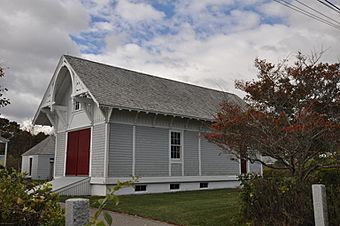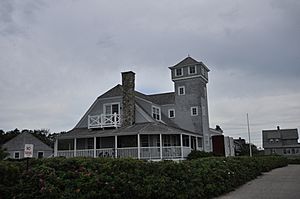Fletcher's Neck Lifesaving Station facts for kids
Quick facts for kids |
|
|
Fletcher's Neck Lifesaving Station
|
|

The 1874 station
|
|
| Location | Ocean Ave., Biddeford Pool, Maine |
|---|---|
| Area | 1 acre (0.40 ha) |
| Built | 1874 |
| Built by | United States Life-Saving Service |
| Architectural style | Stick/eastlake |
| NRHP reference No. | 74000195 |
| Added to NRHP | November 1, 1974 |
The Fletcher's Neck Lifesaving Station was a special place in Biddeford, Maine, built to help people in trouble on the ocean. It was located in the Biddeford Pool area, right by the sea.
This station was started in 1874 by the United States Life-Saving Service. Its first building is one of the oldest and best-kept stations from that time. It was one of the very first five stations built along the coasts of Maine and New Hampshire.
Later, a bigger station was built next to the original one in 1938. The Fletcher's Neck Lifesaving Station was actively used for rescues until 1971.
Contents
What is a Lifesaving Station?
A lifesaving station was like a fire station, but for the ocean! Its main job was to save sailors and passengers from shipwrecks. Crews at these stations would watch the sea, especially during storms. If a ship was in danger, they would launch boats to rescue people. They also helped recover items from wrecked ships.
Where is Fletcher's Neck?
Biddeford Pool is a piece of land that sticks out into the Gulf of Maine. This area is on the southern coast of Maine, just south of where the Saco River meets the ocean. The Fletcher's Neck Lifesaving Station is on the southeast side of this land, near the corner of Fourth Street and Ocean Avenue.
The Original 1874 Station
The first station, built in 1874, looks a bit like a small garage. It has a sloped roof and is about one and a half stories tall. The front of the building faces the ocean. It has a large, double door where equipment like rescue boats would be stored.
The roof has wide overhangs on all sides. These overhangs are held up by large, decorative brackets. Each bracket has a carved dolphin in the middle, which is a cool detail! The walls under the roof overhangs are made of vertical wooden boards. The rest of the building is covered in horizontal wooden siding.
Inside, the main floor had a big area for equipment. Behind this, there was a shared kitchen and a lounge. The attic floor had living spaces for the station's keeper and six crew members.
The Newer 1938 Station
Next to the old building is the much larger station built in 1938. This building has two stories and is made in a style called Shingle-style. It also has two large equipment bays on its right side.
A tall, four-story tower stands out on this building. At the very top of the tower, there was an observation room. From here, crew members could look out over the ocean and spot ships in distress.
History of the Life-Saving Service
The United States Life-Saving Service was created by the U.S. government in 1874. Its goal was to provide rescue services along the nation's coastlines. The Fletcher's Neck station was one of the first five stations opened in Maine and New Hampshire. It officially started helping people on December 1, 1874.
Later, the Life-Saving Service joined with another group to form the United States Coast Guard. The Coast Guard then built the larger station in 1938. The station was still very active in 1945. All Coast Guard activities at Fletcher's Neck officially ended in 1971.




